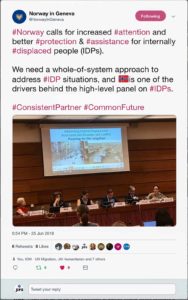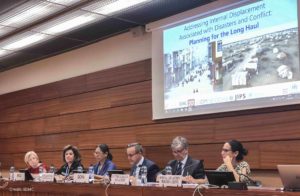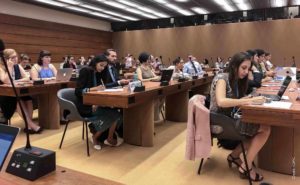Since the Guiding Principles on Internal Displacement were published in 1998, significant efforts and resources have been invested to better understand and address the global phenomenon of internal displacement. It seems, however, that rarely do we take the time to learn across conflict and disaster displacement contexts. Despite the many similarities, these situations are still largely treated in isolation from each other – even within institutions and organisations.
 With the objective of exploring the parallels and distinctions of these displacement contexts, the group working to implement the Plan of Action for Advancing Prevention, Protection and Solutions for IDPs, launched in 2018 to mark the 20th anniversary of the Guiding Principles on Internal Displacement (GP20), organised a side event at the ECOSOC Humanitarian Affairs Segment (HAS) 2019, entitled “Addressing internal displacement associated with disasters and conflict: planning for the long haul”.
With the objective of exploring the parallels and distinctions of these displacement contexts, the group working to implement the Plan of Action for Advancing Prevention, Protection and Solutions for IDPs, launched in 2018 to mark the 20th anniversary of the Guiding Principles on Internal Displacement (GP20), organised a side event at the ECOSOC Humanitarian Affairs Segment (HAS) 2019, entitled “Addressing internal displacement associated with disasters and conflict: planning for the long haul”.
A panel discussion moderated by Hansjoerg Strohmeyer (UN OCHA) was comprised of Cecilia Jimenez-Damary (UN Special Rapporteur on the human rights of IDPs), Mayada Al-Karaghouli (Permanent Mission of Iraq in Geneva), Monique Pariat (European Civil Protection and Humanitarian Aid Operations, ECHO), Bina Desai (Internal Displacement Monitoring Centre, IDMC) and Prof. Walter Kaelin (Platform on Disaster Displacement).
The room was packed with representatives from UN Member States, NGOs and UN agencies, which was impressive given that the event took place after working hours and during a heat wave in Geneva. Speakers brought attention to the different types of internal displacement and how these are linked, the critical data and knowledge gaps that we need to address, and the need for a more collaborative way of working within and between different stakeholders.
Estimates of the number of people displaced each year by disasters have for many years been higher than the number displaced by conflict. The conditions leading up to displacement may also be different in that people uprooted by disasters do not always experience an intentional or targeted violation of their human rights as is often the case in conflict-induced displacement situations. However, as Prof. Walter Kaelin pointed out, many parallels can be observed once people are displaced as they experience similar displacement-related needs and protection risks, including gender-based violence and exacerbation of pre-existing forms of discrimination. He summarized that no matter the cause, internal displacement is a process of loss of housing, livelihoods, property ties and more.
At the same time, he highlighted that the different types of internal displacement can be difficult to distinguish as the causes are often interlinked. For example, the effects of climate change can exacerbate conflict. This leads to a number of challenges, in particular when it comes to obtaining an adequate evidence base that can inform effective responses to displacement. As Bina Desai underlined, there are still important knowledge gaps as datasets are often not comparable, overlapping drivers could be better understood, and even basic data – e.g. on the number of people evacuated, the duration and severity of their displacement, the places IDPs go to, etc. – is missing.
While more investment is needed to fill these gaps, progress has nevertheless been made over the past years. This includes the efforts coming through the Expert Group on Refugee and IDP Statistics (EGRIS) under the mandate of the UN Statistical Commission, to establish international standards and operational guidance to improve and streamline official statistics on forcibly displaced persons. Notably, this guidance will be relevant in both conflict and disaster displacement contexts, as are other standards such as the Guiding Principles.

The panel of the GP20 side event at the ECOSOC Humanitarian Affairs Segment included: Hansjoerg Strohmeyer (moderator, UN OCHA); Cecilia Jimenez-Damary (UN Special Rapporteur on the human rights of IDPs); Mayada Al-Karaghouli (Permanent Mission of Iraq in Geneva); Monique Pariat (ECHO); Bina Desai (IDMC); and Prof. Walter Kaelin (Platform on Disaster Displacement).
As Cecilia Jimenez-Damary explained, the Inter-Agency Standing Committee (IASC) Framework on Durable Solutions for IDPs applies in all internal displacement situations, outlining the criteria and principles for achieving a durable solution. Whether displaced by conflict or disasters, IDPs may achieve a durable solution through return and reintegration in their places of habitual residence, local integration or settlement elsewhere in the country.
Against common assumptions, return isn’t always a possible or desired option for IDPs, whether displaced by conflict or disasters – a fact well known to JIPS based on profiling findings from various contexts and a point that IDPs have repeatedly made to me in my field work. In the case of Somalia, recurring drought makes return difficult for many IDPs, while urbanization is making cities attractive places to stay, contributing to the protracted displacement situation in the country. National development planning informed by results from a 2016 profiling exercise and community-based action plans are part of a larger Durable Solutions Initiative elaborated to facilitate solutions.
In Iraq, millions of IDPs have returned. Returns have been addressed in the context of national recovery and rehabilitation initiatives, such as repair of damaged infrastructure, mine clearance, issuance of official documentation, mobile healthcare clinics and peacebuilding efforts. As Mayada Al-Karaghouli made clear, this required wider government cooperation with, and support from the international community and faith-based organisations. This said, I noted that conflict displacement seems to overshadow disaster displacement in Iraq, as there was no mention of IDPs recently displaced by floods.

The GP20 side event to the ECOSOC Humanitarian Affairs Segment in June 2019 received a lot of interest, as this fully booked room demonstrates.
This leads me to an important point made repeatedly throughout the discussion: improved collaboration is essential to effectively address internal displacement. As highlighted by the panellists from Iraq, ECHO and the Platform on Disaster Displacement, this means not only better linking humanitarian and development actors through evidence, programming and strategy, but also adopting a whole-of-government approach that meaningfully engages IDPs and displacement-affected communities, as in Somalia.
To facilitate such collaboration, a change in our way of working is necessary. ECHO has recently gone through this institutional mindset shift. As a result, the institution is modifying its funding approach to be able to support longer-term planning for recovery, rehabilitation and development needed to address internal displacement situations. This is easier said than done, as it requires strong leadership and rethinking long-established routines, at both headquarters and field level.
The ECOSOC HAS side event highlighted that more attention, investment and work is required in four areas:
These gaps can all be addressed through the GP20 Plan of Action, galvanizing more joined up action amongst the work of all relevant stakeholders, including on data collection and analysis and engagement of IDPs with governments and others. With the Plan halfway through implementation, the time is now to step up action on these priorities. The work done through GP20 will be collated, analysed and shared with the eventual High-Level Panel on Internal Displacement in 2020.